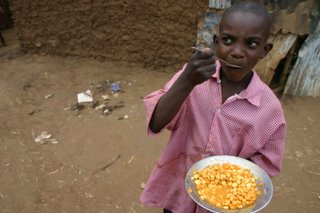Freelance-a-rama
Back to Africa, the trip that’s been talked about, debated, mulled and otherwise decided for months now. Seems like I just got back, seems like I’ve been home for a long time. Seems like I didn’t get enough time to say good-bye, seems like with some people and some places, there wasn’t as much need to say good-bye as I thought there would be.
It’s been a struggle for the past few days to remind myself about why I’m really going. I’m excited to go, I’m anxious to go, I want to go. I’m scared to go. I’m nervous about what awaits, I’m afraid that I’ll be lonely or bored or broke or worse. I have no idea what awaits, I’m not really sure what I’ll be doing when I get there, other than scrambling for a few days. I know that it will be much different from Ghana. I’m just hoping it goes as well as I’ve been envisioning – which is pretty well.
These are the first words I wrote in my journal when I landed in Africa for the fourth time. Almost six months later, I can say with absolute certainty that journalism, Africa-style, has ruined me.
Last week I saw three movies. I had five naps, some of them for two hours. I read two books. I did three interviews, wrote two stories, planned an excursion to the slums and lined up an out-of-town trip. I spent an entire afternoon walking up and down the streets of downtown Nairobi looking to replace a pair of pants. (Without success. One shopkeeper, bless her, told me that she didn’t carry a single thing in my size. “You’re too small. I don’t even have anything for you in Italian sizes. If you fatten up you can come back.”)
How could I do all this with an office job? Bleech.
Until last week, I was $60 shy of having my earnings meet my expenses, including the $2,000 ticket over here. Then last week I spent nearly $400 on hotels, books, movies, postage, paintings, transport, a safari, food and phone cards.
It has indeed been very lonely, which I attribute 100 per cent to traveling. I meet people, but it seems like every one of my friendships right now is sustained via email. There have been definite periods of boredom. (Hence the three movies and two books – “The White Masai” and “Gorillas in the Mist.” Both excellent.)
There is a constant worry about running out of money. And as my parents can attest after a 4 a.m. phone call this week, there is a very real panic when I can’t access my money.
There is an intense longing for Kraft Dinner. And Doritos. And chicken peanut stew.
Of course, there are so many great moments. In Kibera, a slum of epic proportions, a little kid came running up and slapped me high five. He was so intensely adorable, I thought about snatching him. He thought I was Drew Barrymore, which, as you can imagine, happens all the time. Apparently when she was on a goody-goody tour at some point, she came with the World Food Program along the same goody-goody route I was following and had her picture taken with him. Several, in fact, until he accidentally scratched her and she dropped him like a hot potato, afraid that she’d contracted HIV.
Watching Rotarian Doug Cunningham do the hokey pokey for a bunch of kids at Mkuki, while they looked on stunned, mesmerized even, will likely stay with me forever. So will watching as the kids at the Kilema hospital got into the spirit of a game called “Doggie, Doggie Where’s your Bone?”
The kids here are really unbelievable, I mean, they sort of defy description. They have endless imagination, seem to take pleasure in the smallest of things, can turn almost anything into a toy. They’re well-behaved in an almost militant way. They seem to love cameras, break out into the most darling smiles at the smallest provocation, behave like little diplomats. (Kids at Kibera’s Kikoshep primary class sang “We welcome you!” when I stopped in, until they got a little too into the song and jolted one of the desks, sending a sleeping child tumbling to the floor, where she put her tooth through her lip. Then I had my own Drew Barrymore moment of alarm. Some 70 per cent of the kids in the school are HIV-infected orphans.)
It’s hard to watch what is happening to them. It’s hard to know that they are probably one of the biggest problem the world is facing: lonely, starving and parentless, with a loose moral grounding and a vulnerability that is almost shocking.
I suspect that if they continue to be ignored and neglected, in 10 years time, these sweet-faced children will have the street smarts to do something unspeakable about it.
It’s been a struggle for the past few days to remind myself about why I’m really going. I’m excited to go, I’m anxious to go, I want to go. I’m scared to go. I’m nervous about what awaits, I’m afraid that I’ll be lonely or bored or broke or worse. I have no idea what awaits, I’m not really sure what I’ll be doing when I get there, other than scrambling for a few days. I know that it will be much different from Ghana. I’m just hoping it goes as well as I’ve been envisioning – which is pretty well.
These are the first words I wrote in my journal when I landed in Africa for the fourth time. Almost six months later, I can say with absolute certainty that journalism, Africa-style, has ruined me.
Last week I saw three movies. I had five naps, some of them for two hours. I read two books. I did three interviews, wrote two stories, planned an excursion to the slums and lined up an out-of-town trip. I spent an entire afternoon walking up and down the streets of downtown Nairobi looking to replace a pair of pants. (Without success. One shopkeeper, bless her, told me that she didn’t carry a single thing in my size. “You’re too small. I don’t even have anything for you in Italian sizes. If you fatten up you can come back.”)
How could I do all this with an office job? Bleech.
Until last week, I was $60 shy of having my earnings meet my expenses, including the $2,000 ticket over here. Then last week I spent nearly $400 on hotels, books, movies, postage, paintings, transport, a safari, food and phone cards.
It has indeed been very lonely, which I attribute 100 per cent to traveling. I meet people, but it seems like every one of my friendships right now is sustained via email. There have been definite periods of boredom. (Hence the three movies and two books – “The White Masai” and “Gorillas in the Mist.” Both excellent.)
There is a constant worry about running out of money. And as my parents can attest after a 4 a.m. phone call this week, there is a very real panic when I can’t access my money.
There is an intense longing for Kraft Dinner. And Doritos. And chicken peanut stew.
Of course, there are so many great moments. In Kibera, a slum of epic proportions, a little kid came running up and slapped me high five. He was so intensely adorable, I thought about snatching him. He thought I was Drew Barrymore, which, as you can imagine, happens all the time. Apparently when she was on a goody-goody tour at some point, she came with the World Food Program along the same goody-goody route I was following and had her picture taken with him. Several, in fact, until he accidentally scratched her and she dropped him like a hot potato, afraid that she’d contracted HIV.
Watching Rotarian Doug Cunningham do the hokey pokey for a bunch of kids at Mkuki, while they looked on stunned, mesmerized even, will likely stay with me forever. So will watching as the kids at the Kilema hospital got into the spirit of a game called “Doggie, Doggie Where’s your Bone?”
The kids here are really unbelievable, I mean, they sort of defy description. They have endless imagination, seem to take pleasure in the smallest of things, can turn almost anything into a toy. They’re well-behaved in an almost militant way. They seem to love cameras, break out into the most darling smiles at the smallest provocation, behave like little diplomats. (Kids at Kibera’s Kikoshep primary class sang “We welcome you!” when I stopped in, until they got a little too into the song and jolted one of the desks, sending a sleeping child tumbling to the floor, where she put her tooth through her lip. Then I had my own Drew Barrymore moment of alarm. Some 70 per cent of the kids in the school are HIV-infected orphans.)
It’s hard to watch what is happening to them. It’s hard to know that they are probably one of the biggest problem the world is facing: lonely, starving and parentless, with a loose moral grounding and a vulnerability that is almost shocking.
I suspect that if they continue to be ignored and neglected, in 10 years time, these sweet-faced children will have the street smarts to do something unspeakable about it.

















